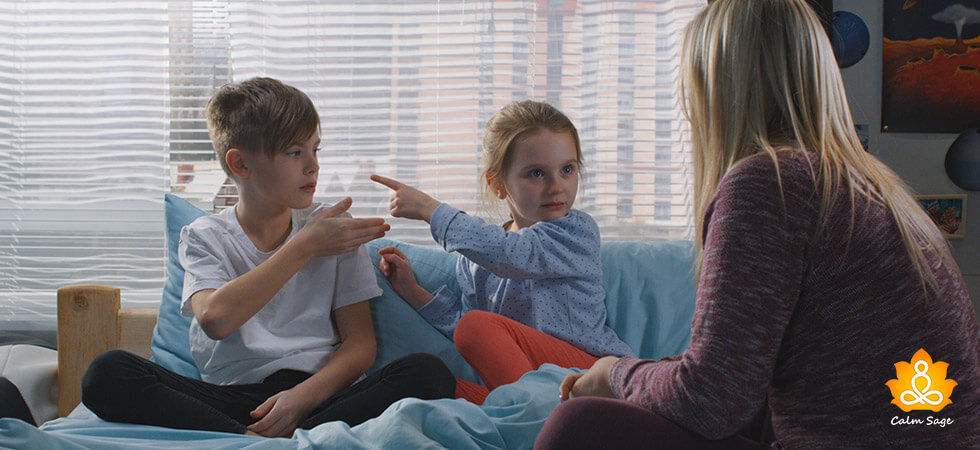When Siblings Go to War: The Signs and Impact of Sibling Abuse

We all have those moments with our siblings – from fierce competitions to inside jokes. But, what if those playful and tough love turned into something more toxic and sinister? Beneath all those petty squabbles and teasing lies an under-exaggerated type of abuse. Yes, you guessed it – sibling abuse or sibling bullying.
I never heard of this term before I began researching toxic forms of sibling rivalry, but here I am! I’m sure that, just like me, you have never heard of sibling abuse before. Well, let’s rectify that, shall we?
List of Contents
Sibling abuse refers to a repeated pattern of harmful or abusive behavior inflicted by one sibling on another. This abuse can take different forms – from physical violence to emotional manipulation, and even sexual assault.
It’s important to understand the difference between normal sibling bickering and rivalry that occurs between siblings from sibling abuse. This form of abuse can be characterized by an imbalance of power, with one sibling consistently dominating and controlling the other. This kind of imbalance leaves the targeted sibling feeling unsafe, isolated, and emotionally drained.
So, how can we recognize the signs of sibling abuse? Keep reading to explore what sibling abuse looks like, its impact on our lives, and how you can address and prevent it.
Signs of Sibling Abuse
While sibling rivalry and bickering are a part of growing up with a sibling, it pales in comparison to the cruelty and evilness of sibling abuse. Here’s how you can recognize the signs of sibling abuse;
Physical signs;
- Unexplained bruises or injuries
- Damaged or destroyed belongings
- Fearful behavior around a sibling
Emotional signs;
- Sudden mood changes including depression, anxiety, and anger
- Trouble sleeping
- Experiencing nightmares
- Low self-esteem
- Feelings of worthlessness
- Loss of interest in once enjoyable activities
- Social withdrawal and isolation
Behavioral signs;
- Trouble trusting others
- Trouble forming healthy relationships
- Self-destructive behaviors like self-harm, substance abuse, etc.
- Rebellious and defiant behavior
- Trouble expressing your needs openly
- Constant hostile interactions with a sibling
- Fear of speaking up
Types of Sibling Abuse
Sibling abuse can be a multifaceted creature capable of inflicting pain in various ways. Some common types of sibling abuse can include;
- Physical Abuse: This includes hitting, kicking, shoving, biting, and any act of physical violence
- Emotional Abuse: This includes threats, humiliation, verbal attacks, belittling, and social exclusion
- Social Abuse: This includes spreading false rumors, isolating the abused from their friends, or sabotaging their social life
- Financial Abuse: This includes stealing money from the abused or preventing them from gaining financial independence
- Sexual Abuse: This includes unwanted sexual contact, pressure, or straight-up assault from a sibling
The Impact of Sibling Abuse
The wounds inflicted by sibling abuse might be invisible and under-exaggerated, but they are deeply damaging. Victims of sibling abuse can experience;
- Low self-esteem due to constant belittlement. This kind of abuse from someone who is supposed to be your best friend can leave you feeling worthless and incapable of standing up for yourself.
- High depression and anxiety because of the fear and stress of the abuse. The abuse from a sibling can lead to a constant state of unease, anxiety, anger, and depression.
- Post-trauma stress can also be another effect of sibling abuse. In severe cases, the trauma of the abuse from a sibling can manifest as PTSD, characterized by flashbacks, nightmares, and hypervigilance.
- Poor relationships can also be another effect. You, as a victim of sibling abuse, might struggle constantly to form healthy relationships due to trust issues and emotional baggage thrown in by your abusive sibling.
Addressing Sibling Abuse…
If you suspect signs of sibling abuse in your household or a loved one’s house, then here’s how you can address this form of abuse;
- Seek Safety: The first thing you need to do is go to a place where you feel safe. Safety is paramount in cases of abuse. If physical violence is a threat, then involve a trusted person to step in immediately.
- Talk About It: If it feels safe, then communicate with your siblings about the behavior they are presenting to you. Keep your voice and tone calm and supportive. If you know someone is being abused, then let them know you’re there for them.
- Seek Professional Intervention: If the situation is worse, then consider seeking professional intervention. Involving a family therapist to help address the abuse can help. Do this only if you feel safe. Therapy can help you process your emotions and develop healthy coping strategies to deal with abusive behavior from a sibling.
How to Prevent Sibling Abuse?
While abuse can be quite challenging to deal with, you can take proactive measures to prevent it and create a healthy environment. Here are some ways to prevent sibling abuse;
-
Set Boundaries:
You can start by calmly but firmly telling your sibling that their behavior is unacceptable. Use “I” Statements to make your point. If your sibling gets physically violent, then find a safe space immediately. If they fail to respect your boundaries, then you can limit contact with them.
-
Have a Support System
Confide about your predicament to a trusted friend, family member, or counselor – someone who understands the situation. Practice calming techniques to keep your fear and anger at bay. You can also engage in activities that make you feel good about yourself. This can help boost your self-confidence.
-
Document The Abuse
If possible, discreetly document the abuse. This could include writing down the incidents, taking pictures of physical injuries, or keeping voice memos (if legal in your region). This kind of proof and documentation can help you seek further help and professional intervention.
-
Have an Exit Plan
In any case, have an exit plan ready. This could include going to a friend’s house or a safe space in your home. Familiarize yourself with local hotlines or support groups for abuse victims. Having an escape plan in hand can make you feel empowered to seek help if needed.
-
Lastly, You’re Not Alone
Whatever you do, keep in mind that sibling abuse isn’t your fault if you’re a victim. You’re not alone in this, and there are people ready to help you if you need it. Your safety is important, so don’t hesitate to seek help from a trusted person or contact emergency services if you feel threatened or unsafe with your sibling.
Wrap Up…
Sibling bonds are precious, but when love turns toxic, it can leave long-lasting scars that might take years to heal. Recognizing the signs of sibling abuse, responding thoughtfully, and incorporating preventive measures to prevent sibling abuse, can help you and your sibling work on your relationship on a path of respect, understanding, and love.
Remember, a healthy sibling relationship is where you and your siblings feel safe, validated, and empowered to be your best selves. Let’s work on that for the sake of all siblings, shall we?
Let us know what your sibling relationship looks like and how you show your support and love to your siblings in times of need in the comments below.
Until next time, take care!
Next Read:




















